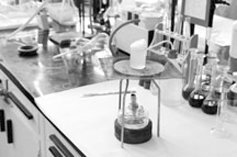Methamphetamine History Part 2
The US Midwest Was Hard-Hit by Meth

One of the chemicals needed for methamphetamine is anhydrous ammonia, a chemical frequently used by farmers as fertilizer. And so rural areas of the US became popular places to cook small batches of methamphetamine. And not just because of the availability of ammonia. Also because remote, rural properties were better for the manufacture of these stinky, toxic batches of drugs and because one of the primary public for this drug was the blue collar worker.
As the economy changed toward the end of the twentieth century, many blue-collar workers driving trucks or working in meatpacking or manufacturing plants were forced to work long hours to make ends meet. They met the demand for more work with methamphetamine purchased from a small mom-and-pop operation in their town. Meth increased their energy and let them work double shifts but created addiction and physical deterioration.
When methamphetamine was allowed to crystallize into “ice” methamphetamine, it could be smoked. This new drug hit the illicit market and became popular with people who did not want to inject drugs. But it was more quickly addictive and very hard on the body.
In 1996, there were more laws passed to control the chemicals needed to make methamphetamine. As each law was passed, drug manufacturers just shifted their purchasing patterns. Mexican suppliers were buying ephedrine from Germany, Czech Republic, China and India, and supplying Superlabs in the Central Valley of California. One of the major supply channels was found and shut down by law enforcement, resulting in a lower purity of the drug on the street.
By law, ephedrine pill sellers had to keep tabs on who was buying their pills but no such controls were placed on cold medication sellers. So small meth operations began buying cold medications to make their drugs. Pseudoephedrine had to be stripped out of the pills, therefore toxic, flammable chemicals were used to perform this step. Meth labs then became very susceptible to explosion. A member of a Central Valley Meth Task Force said, “Before you know it, sixty percent of the labs were dealing with were [having] fires and explosions because they were learning and they were making mistakes.”
The Pseudoephedrine “Blister Packs” Loophole Aided Meth Cooks

The DEA soon placed further regulations on cold medications but exempted “blister packs.” Meth cooks began buying up blister packs in quantity so they could make their batches of meth.
But about the same time, the Mexican drug cartels were increasing their control of the market. They were importing shipping containers of pseudoephedrine from China while small operations were busting open blister packs. Large labs were established in Mexico like they were in the Central Valley.
After 2000, state after state wrestled with the problem of domestic meth production and Mexican meth coming across the border. Oregon made cold medication a prescription-only drug which cut the problems in that state way down. Many other states instituted monitoring systems and laws mandating a maximum of two blister packs per customer. This spurred the development of “smurfing” operations. A meth cook would hire several meth addicts and give them a car and cash. They would go from drugstore to drugstore, buying their legal limits of cold medications. This activity was referred to as smurfing. At meth lab sites, huge piles of blister packs began to be found.
By 2006, the United Nations World Drug Report called methamphetamine the most abused hard drug in the world. American had 1.4 million abusers but the highest concentration of meth addicts was in East and Southeast Asia.
Another, Simpler Method of Methamphetamine Manufacture Arose
In about 2007, a new method of methamphetamine production spread across the US in response to the regulation of pseudoephedrine sales. The One-Pot or “Shake and Bake” method of meth production required much less equipment. A person could simply mix the chemicals in a two-liter soda bottle and let the fumes dissipate. Dangerous meth labs could now be carried around in a car, a backpack or even on a bicycle. But they were still toxic and dangerous. One child was blinded when he found some of these bottles that had been dumped in the woods. When he played with them, one of the bottles exploded. The chemical burns blinded him.
There is still no solution to the manufacture or smuggling of methamphetamine. Laws will continue to be passed in a cat-and-mouse game of control of meth manufacturing.
The solution to manufacture lies in eliminating abuse of the drug. Drug rehabilitation helps those who could not put it down, once they started. The Narconon network across the US and around the world puts both solutions into effect every day.
Methamphetamine has a reputation for creating an addiction from which it is hard to recover. But the Narconon drug rehabilitation program even works for methamphetamine addicts. They are helped through a tolerable withdrawal, supported through the depression that accompanies withdrawal from a strong stimulant like this.
A deep detoxification program follows, utilizing a sauna, moderate daily exercise and nutritional supplements. This combination enables the body to start flushing out the toxins left behind after drugs are abused. As toxins leave, those participating in this step talk about how much lower their cravings are. Some even say they leave entirely.
Then, because addiction normally destroys life skills, the Narconon program includes training courses which restore these skills. Each person needs to know how to face obstacles without retreating into substance abuse, how to make the right decisions to stay productive and sober, and how to recover personal integrity.
By the end, a person recovering from methamphetamine addiction has built himself (or herself) a new life to replace the one destroyed by meth abuse. Learn more about this program that can mean a new hope for recovery for the methamphetamine addict.
Resources:
 ®
®